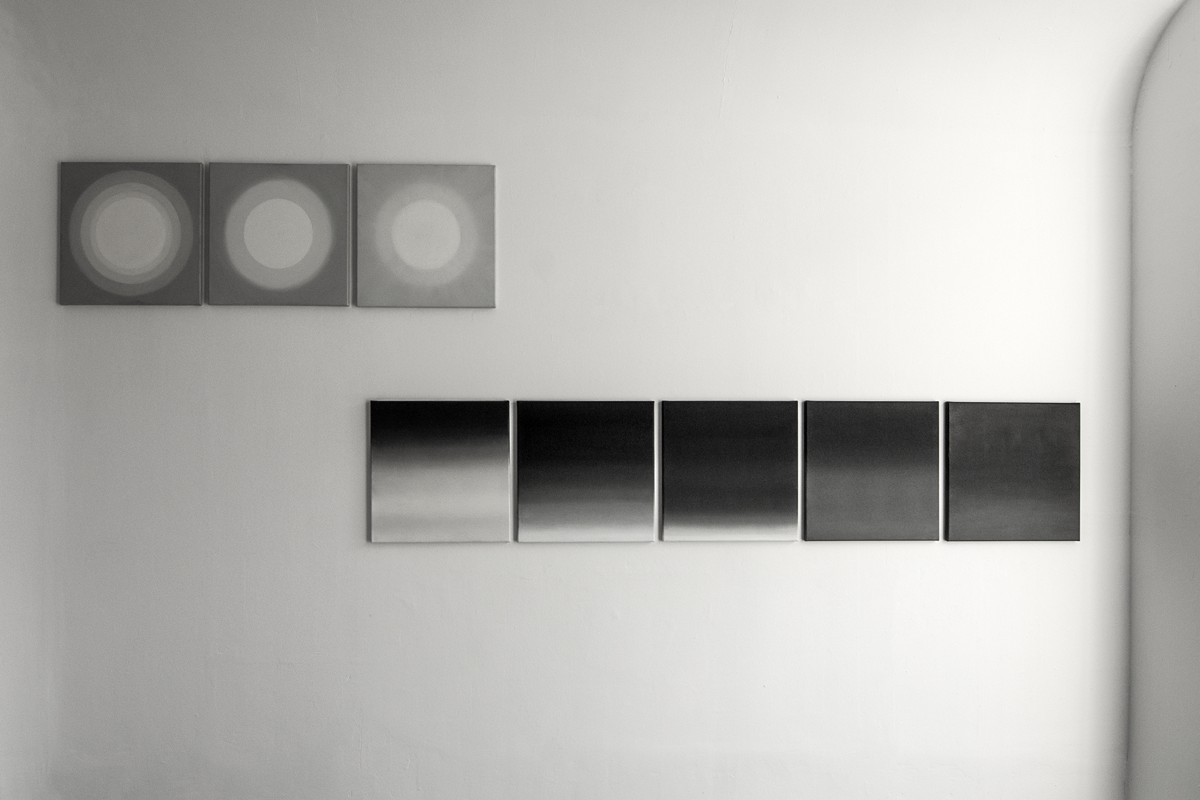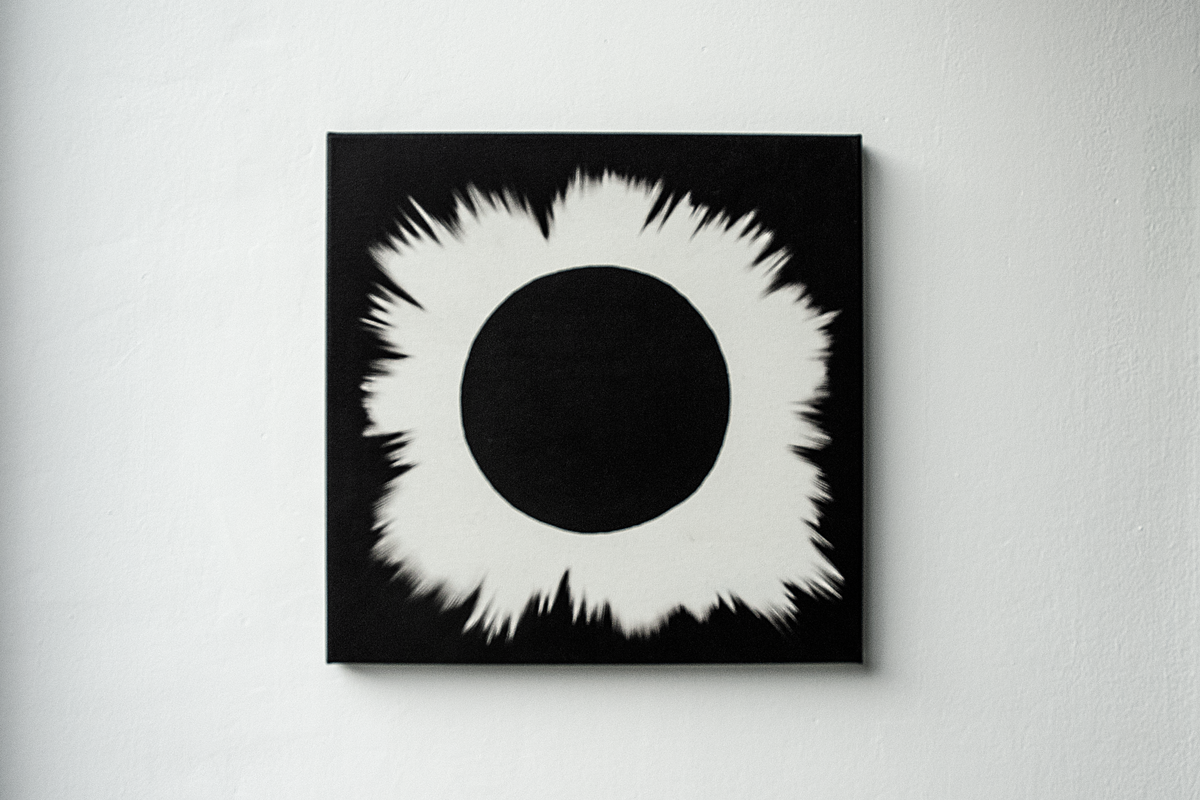Przesilenie / Solstice / 2024 / fotografia / malarstwo / instalacja, photography / painting / installation








Wystawa odbyła się w marcu 2024 w www.pianagallery.com
Malarstwo: Karolina Kowalska, 12 obrazów z serii Przesilenie / Solstice, 2023, olej na płótnie, 40 / 40 cm każdy
Fotografia: Karolina Kowalska, Kalendarz lunarny / Lunar Calendar, 2018, jedna z serii fotografii / one from the series of photographs / 100 / 100 cm
Instalacja: Karolina Kowalska, Monika Krzynówek, Lena Witkowska, Lewitujący obiekt / Levitating Object, 2021, instalacja / installation, 15 / 15 / 40 cm
Przesilenie to moment, w którym dwie zawieszone w kosmosie kule, jedna ognista, druga chłodna na swej powierzchni, ustawiają się wobec siebie w szczególny sposób. Delikatne wychylenie osi naszej planety powoduje cykliczne przemiany, które mają istotny wpływ na funkcjonowanie ekosystemów i poszczególnych form życia. Niewiele ponad dwadzieścia stopni odchylenia od ekliptyki stało się podwaliną większości wierzeń i programów metafizycznych organizujących ludzkie społeczności od dziesiątek tysięcy lat.Karolina Kowalska od lat zajmuje się badaniem wpływu podstawowych energii kosmicznych na działanie naszego otoczenia. Interesowały ją stany przewartościowań i kruchej równowagi pomiędzy siłami organizującymi biosferę.
Wystawa w Pianie prezentuje efekt jej niedawnych rozważań nad światłem słonecznym – tym emitowanym przez najbliższą nas gwiazdę, jak i tym odbitym przez naszego skalistego satelitę. Cykl płócien dokumentujących świecenia, które czasem przyjmują formę dynamicznych rozbłysków, czasem są stabilną emisją i pulsowaniem, to opowieść o historii życia – ponadgatunkowego istnienia, które przyjmuje różnorodne, często trudne do wyobrażenia formy. Miliony istnień, poddanych ciągłym przemianom, ewolucjom i rewolucjom pojawiały się i znikały w cyklu trwającym już cztery miliardy lat. Większości nigdy nie poznamy, nie opiszemy i nie sklasyfikujemy. Przy całej naszej zuchwałej potrzebie nazywania, musimy pogodzić się z faktem, że większość wiedzy pozostanie dla nas niedostępna. W czasach, gdy sonda Voyager 2 znajduje się ponad 19 miliardów kilometrów od Ziemi, a Parker Solar Probe przelatuje przez koronę słoneczną, wnętrze naszej własnej planety pozostaje tajemniczo głuche. Nie mamy wciąż narzędzi, by ten stan zmienić, skazani jesteśmy więc na modele teoretyczne i szukanie analogii.
Opowieść Karoliny Kowalskiej to narracja o relacjach – jawnych i ukrytych związkach, które spinają naszą rzeczywistość. Można ją czytać w makroskali jako historię sieci współzależności ciał niebieskich, lecz sprowadzić możemy ją również na ziemię, do poziomu, w którym promienie słońca oświetlają naszą skórę i dają jej przyjemne ciepło. Do momentu, w którym siła grawitacyjna księżyca porusza cząsteczki wody w naszych organizmach i determinuje nasze samopoczucie. Przesilenie to opowieść o poczuciu zmiany, przewartościowania, o przypływach – wiecznym, rozpisanym na to co mikroskopijne i to, co wszechpotężne, ruchu, którego nie da się zatrzymać, ale można się mu poddać i z wzrastającą świadomością odczuwać całym swoim ciałem.Jak podkreśla artystka, cykl obrazów, ukazujących tę wieczną zmienność mógłby nigdy się nie skończyć. Doskonałe powtórzenie nie może zaistnieć zarówno w malarskim geście, jak i w oszałamiająco złożonej materii, której jesteśmy cząstką. W pracach Karoliny stały jest tylko jeden punkt – centralna drobinka – odcisk cyrkla wykreślającego bieg tarczy słonecznej. Jedna sto dziewiąta powierzchni naszej gwiazdy – to nasza planeta, wiecznie podporządkowana, wiecznie peryferyjna, wiecznie ruchliwa, zmierzająca do niemej zagłady.
Michał Zawada
The exhibition took place in March 2024 in www.pianagallery.com
Malarstwo: Karolina Kowalska, 12 obrazów z serii Przesilenie / Solstice, 2023, olej na płótnie, 40 / 40 cm każdy
Fotografia: Karolina Kowalska, Kalendarz lunarny / Lunar Calendar, 2018, jedna z serii fotografii / one from the series of photographs / 100 / 100 cm
Instalacja: Karolina Kowalska, Monika Krzynówek, Lena Witkowska, Lewitujący obiekt / Levitating Object, 2021, instalacja / installation, 15 / 15 / 40 cm
Solstice is the moment when two spheres suspended in the cosmos, one fiery, the other cool on its surface, align with each other in a particular way. The gentle tilt of our planet's axis causes cyclical changes that have a significant impact on the functioning of ecosystems and individual life forms. A little more than twenty degrees of deviation from the ecliptic has become the foundation of most beliefs and metaphysical programs organizing human societies for tens of thousands of years.Karolina Kowalska has been studying the impact of fundamental cosmic energies on the operation of our environment for years. She has been interested in states of overvaluation and fragile balance between the forces that organize the biosphere.
The exhibition at Piana presents the result of her recent reflections on sunlight - that emitted by the star closest to us, as well as that reflected by our rocky satellite. The series of canvases documenting the glows, which sometimes take the form of dynamic flares, sometimes are stable emissions and pulsations, is a story about the history of life - a trans-species existence that takes on a variety of forms that are often difficult to imagine. Millions of existences, subjected to constant changes, evolutions and revolutions have appeared and disappeared in a cycle that has already lasted four billion years. Most we will never know, describe or classify. For all our audacious need to name, we must accept the fact that most knowledge will remain inaccessible to us. At a time when the Voyager 2 probe is more than 19 billion kilometers from Earth and the Parker Solar Probe is flying through the solar corona, the interior of our own planet remains mysteriously deaf. We still do not have the tools to change this state, so we are doomed to theoretical models and the search for analogies.
Karolina Kowalska's story is a narrative about relationships - overt and covert relationships that bind our reality. It can be read on a macro scale as a story of the network of interdependence of celestial bodies, but we can also bring it down to earth, to the level where the sun's rays illuminate our skin and give it a pleasant warmth. To the point where the moon's gravitational force moves the water molecules in our bodies and determines our well-being. Solstice is a story about the sense of change, of reevaluation, of the tides - an eternal, dissected into the microscopic and the all-powerful, a movement that cannot be stopped, but one can surrender to it and feel with increasing awareness with one's whole body.As the artist emphasizes, a series of paintings showing this eternal changeability could never end. Perfect repetition cannot exist both in the painterly gesture and in the staggeringly complex matter of which we are a part. In Karolina's work, only one point is constant - the central speck - the imprint of the circular wheel plotting the course of the solar disk. One hundred and nine percent of the surface of our star - this is our planet, eternally subordinated, eternally peripheral, eternally moving, heading for silent annihilation.
Michał Zawada




























